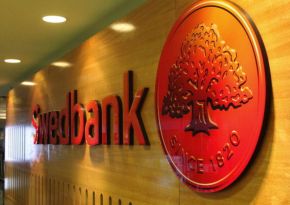Analytics, Economics, EU – Baltic States, GDP, Investments, Markets and Companies
International Internet Magazine. Baltic States news & analytics
Wednesday, 24.04.2024, 16:42
Swedbank: GDP in Baltic States to grow by 3.5-4.2%
 Print version
Print version |
|---|
"In the context of positive global trends, the Baltic countries and
Lithuania look rather good. A recovering Russia and euro area have had a
positive impact on Lithuania's GDP growth. Lithuania's GDP grew by 4% in the
first half of this year and we expect similar growth for the rest of the
year," Swedbank Lithuania's
chief economist Nerijus Maciulis
said at a news conference on Tuesday.
The upward revision of the 2017 GDP growth forecast reflects positive
foreign trade trends, recovering investments and strong household consumption,
he said.
Swedbank also revised its
2018 GDP growth projection upwards to 3.5%, from 2.7% in April. However, the
bank forecasts that the country's economic growth will slow down to 2.5% in
2019.
Swedbank predicts that
inflation in Lithuania will reach 3.5% this year (up from the 3% projection
in April) before decelerating to 3% next year. It expects wages to grow by
8% in 2017 and by 7% in 2018.
Lithuania's exports are forecast to grow by 8% this year and by another 7%
next year. Imports are expected to increase by 10% and 8%, respectively.
Swedbank expects
unemployment in the country to decline by 7.2% this year, from 7.9% in 2016,
and ease further to 6.8% next year.
According to Swedbank’s
forecasts, Latvia’s economy this year and next year will grow by 4-4.2%, but
the growth might slow down if there are no investments, said the bank’s chief
economist Martins Kazaks, presenting
the bank’s latest macroeconomic outlook.
"The earlier "fat years" will not return, but the "good
new times" are here. The world’s economy is growing well, and the growth
will not be steeper. Investments in Latvia’s economy are finally growing, but
they are still very weak. We will not be able to grow without investments. If
we do not invest today, we will miss tomorrow’s opportunities," said Martins
Kazaks.
The economist underscored that Latvia’s gross domestic product rose steeply
in the first half of this year – by 4.1%. Export growth is driven by a strong
external demand, investments are recovering, while improvement of household sentiment
and income promotes consumption rise.
"The economy is growing steeply, while demand for loans is still week
– households and companies seemingly are not rushing with large purchases and
investments. Lending will be important for growth," said Kazaks.
The economist said that, affected by external factors, the growing excise
tax and wage growth, the average annual inflation will reach almost 3% in 2017
and 2018, and will be at 2.2% in 2019.
"The main risks for growth are external – uncertainty related to the
geopolitical situation, weakening of external demand and reduction of Russian
cargo transit flow. Internally, heating up of the job market and excessive wage
growth might threaten competitiveness," said Kazaks.
Swedbank has raised
Estonia's 2017 real growth forecast by 1.3 percentage points to 3.5% and next
year's growth forecast by 0.4 percentage points to 3.2% in its fresh economic
outlook.
In April the bank estimated Estonia's gross domestic product growth to
total 2.2% this year and 2.8% in 2018. In 2019 the country's economic growth is
to total 2.7%, the bank said on Tuesday.
Foreign demand is expected to remain robust in the next two years. In
addition to the positive impact on exports, this increases the need for
business sector investments, as capacity utilization in industry has already
risen above its long-term average, Swedbank
said.
After a slowdown this year, growth of private consumption is expected to
accelerate again in 2018. The bank forecasts that next year the Estonian economy
will grow by 3.2% and in 2019 by 2.7%. At this stage of the growth cycle,
Estonia does not need stronger fiscal stimulation, the bank said.
Consumer price growth is expected to accelerate above 3% in 2017 due to
higher commodity prices and a surge in excise tax rates. Strong wage growth
will lift the prices of services. Growth of the average wage in real terms is
expected to slow substantially this year, as nominal growth of wages will be
somewhat slower and prices will rise.
The substantially slower growth of wage-earners' purchasing power will be
smoothed by an increase in social transfers. In 2018, wage-earners' labor
income will jump up again, due to a substantial increase in their nontaxable income.
This change in taxes could also lower their wage expectations for next year.
Wage growth will remain relatively high due to the shortage of suitable
labor. The higher economic activity is lifting employment in 2017. In 2018,
employment is expected to remain at around this year's high level, as the labor
supply will be limited despite the growing demand for labor, Swedbank said.








 «The Baltic Course» Is Sold and Stays in Business!
«The Baltic Course» Is Sold and Stays in Business!

